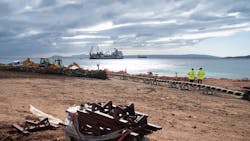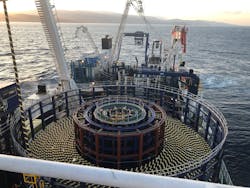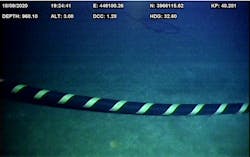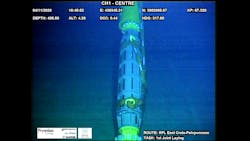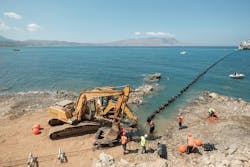Submarine HV Cable Designed for Deepwater Applications
Historically, the design of high-voltage submarine cables includes steel tensile elements (armoring) stranded around the circumference of the power cable core. Typically, the steel tensile elements are galvanized to protect against corrosion. The main purpose of the tensile elements is to support the weight of the cable, as it is suspended from the cable-laying vessel to the seabed while being installed (or recovered). Within the design of high-voltage (HV power cables, it is important the elongation of the conductors, and thus the cable, is limited to a very low level. Therefore, it is necessary to provide tensile elements with sufficient tensile modulus of elasticity and cross-sectional area to ensure minimum cable elongation.
The steel stranding added to provide more elasticity area also increases the weight of the cable. The tensile strength elements at any point along the cable during installation must support the total weight of the cable while maintaining the cable elongation below the desired level. The position on the cable subjected to the highest stress (and strain) is the point on the cable just as it leaves (or enters) the cable-laying vessel, where the tensile elements are supporting the total weight of the cable between this point and the seabed. Depending on the depth of the water, the weight of the suspended cable will cause cable elongation outside the specified design limits.
To resolve this cable elongation problem, it has been a long-term goal of manufacturers to design and build submarine cables that are as light as possible without compromising the cable’s mechanical and electrical performance, which could enable the deployment of cost-efficient and fit-for-purpose solutions. The Independent Power Transmission Operator SA (IPTO) in Greece successfully installed such a submarine cable design recently to interconnect the Greek islands.
Submarine Cable Design
Steel tensile elements in a typical submarine cable have a density of about 8 g/cu cm (4.6 oz/cu inch) and a tensile modulus of elasticity of about 200 GPa. A gigapascal (GPa) is a decimal multiple of the pascal, which is the International System of Units (SI) derived unit of pressure, stress, Young's modulus and ultimate tensile strength. Synthetic yarns can have densities between 1 g/cu cm and 1.5 g/cu cm (0.58 oz/cu inch and 0.86 oz/cu inch) and a tensile modulus of elasticity of around 100 GPa. In theory, it is possible to replace 1 sq cm (0.16 sq inch) of the steel tensile elements with about 2 sq cm (0.32 sq inch) of synthetic tensile elements — to have the same elasticity area — but the synthetic tensile element will weigh around 70% less than the steel.
A polymeric sheath is extruded around the synthetic yarns mainly to protect the yarns during cable manufacture. When the tensile elements are applied to the cable (in one or more layers), they are covered then by one or more layers of polypropylene rope, with the typical yellow or white stripe, which gives them their characteristic appearance.
Comparison of Cables
The following alternative tensile element design solutions were considered by IPTO in Greece: galvanized steel, stainless steel and synthetic fiber. The following performance characteristics were analyzed:
- Effect on electrical losses during operation — Stainless-steel and synthetic fibers are nonmagnetic and, therefore, do not cause electrical losses.
- Thermal conductivity and its effect on ampacity and maximum conductor temperature — Synthetic fibers have lower thermal conductivity than metallic elements, which needs to be taken into consideration.
- Weight-to-stiffness ratio and its effect on installation suitability — Synthetic fibers have a much lower density than the two metal alternatives.
Stainless-steel and synthetic-fiber tensile elements have performance characteristics greater than or equal to galvanized steel with respect to cable elongation, steady-state electrical losses, continuous current rating, conductor temperature, cable breaking strength, cable weight and cable-laying tension.
Although stainless-steel tensile elements provide a slightly higher continuous current rating and a lower conductor temperature than synthetic-fiber tensile elements, the reduced weight of the synthetic-fiber tensile elements make this solution preferred for very deepwater applications.
Prototype Testing
A project-specific type test was performed on a prototype cable with synthetic-fiber tensile elements. Mechanical tests simulating the project-specific installation conditions and methodology were performed in accordance with anticipated customer specifications.
The cable test sample included newly developed factory joints and a rigid repair joint. The maximum pulling tension for the tensile bending test was 450 kN, and the same value was applied for the straight tensile test. These results were deemed satisfactory as the type test was performed successfully to qualify the cable design for deepwater installation at the maximum water depth of 1000 m (3280 ft), in accordance with CIGRE Technical Brochures 623 and 490 as well as relevant International Electrotechnical Commission standards.
Longitudinal (conductor and sheath) and radial (factory joint and repair joint) water-penetration tests were performed at 96 bar, in accordance with the design-approved maximum water depth, and the cable system (cable and accessories) successfully passed all tests.
Greek Transmission System
Cable manufacturer Prysmian Group found a partner in the IPTO in Greece that was willing to provide suitable applications for this new cable technology. The goal of the projects was to ensure the HV cable satisfied power transmission requirements with the additional capability of allowing for cost-effective and safe cable installation at increased water depths.
The Greek transmission system includes many non-interconnected inhabited islands. These islands are located mostly in the deepwater regions of the Aegean Sea, with a maximum sea depth of 3543 m (11,625 ft), and the Ionian Sea, with a maximum sea depth 5267 m (17,280 ft) — the deepest sea depth in the Mediterranean. Most of the large Greek islands, namely Crete and Rhodes, have significant power requirements.
The cable design selected for all interconnections was a 150-kV alternating-current (ac), three-core cable with 630-sq mm (0.98-sq inch) copper conductors and two layers of flat tensile elements containing high modulus synthetic fibers. The first installation selected for this new cable design was the connections between the three Greek islands of Evia, Andros and Tinos. A second installation selected was the long subsea interconnector between Crete and Peloponnese on the Greek mainland.
Inter-Island Connections
The first 2.5-km (1.55-mile) length of 150-kV submarine cable was installed between Andros and Tinos, and the second 14-km (8.7-mile) 150-kV submarine cable was installed between Andros and Evia. The sea state during cable installation on the seabed at a maximum depth of 550 m (1805 ft) had a wave height of 1.5 m (4.9 ft) that corresponded to a laying tension on the order of 200 kN.
The cable installation required four beach pulls, two of which were undertaken at the island substation located some 150 m (490 ft) from the shoreline. The low cable weight enabled this operation to be completed without any additional risks during installation, which went smoothly and was executed according to plan without any incidents.
The installation of the two Evia-Andros-Tinos low-loss 150-kV island interconnectors kicked off in September 2019 and concluded in November 2019, with both interconnectors in commission by February 2020.
Crete-Peloponnese Interconnector
A third interconnection using synthetic-yarn tensile elements was installed between Crete and Peloponnese. This interconnection of Crete — the biggest island in Greece — with the Greek mainland was originally envisaged in the early 1970s. The electricity production sector in Crete is responsible for approximately 60% of the island’s CO2 emissions, as a result of using heavy fuel oil (HFO) and diesel in the power plants.
Therefore, the key objectives for this interconnector project were as follows;
- Reduce CO2 emissions attributed to the oil-fired stations by replacing these power plants with generation from natural gas and renewable energy sources (RES) enhanced by the interconnector to the mainland.
- Reduce electricity generation costs in Crete by replacing expensive oil-fired generation units with more efficient generation from the mainland of Greece.
- Reduce the emissions of pollutants (for example, NOx and SO2), which will have a positive effect on the environment and tourism.
- Contribute significantly to the increasing demand for energy using RES (wind and solar) installed on the island of Crete.
- Improve the security of supply for customers on the island.
The Crete-Peloponnese interconnector project connects Crete to the Greek mainland transmission system on the Peloponnese Peninsula. The total length of the submarine cable interconnector is approximately 135 km (84 miles), laid at a maximum installation depth of 960 m (3150 ft) with a total submarine cable length of approximately 135 km. This 150-kV interconnector has a load-transfer capacity of 200 MVA.
During cable laying at the deepest point of the installation, the aramid armored cable was subjected to a laying tension of about 340 kN — approximately 46% less than the respective tension of a conventional galvanized-steel double-armored submarine cable used for deepwater interconnections. Correspondingly, the weight of the aramid armored cable was approximately 34 kg/m (23 lb/ft), some 47.5% less in comparison with a conventional submarine cable.
The Crete-Peloponnese project confirmed the measured onboard tension of aramid armored cable increases linearly as the depth of lay increases, as shown by data extracted from the daily installation progress reports. It was clear the forces a submarine cable with synthetic-fiber tensile elements experiences during cable-laying installation were significantly less than those subjected to a conventional cable.
The submarine cable installation required two beach pulls, thereby consisting of two laying campaigns. The first campaign was from Nopigia in Crete to the 67th-km (42nd-mile) position of the interconnection (KP 67), while the second campaign extended from KP 67 to Neapolis, Peloponnese. Two in-line cable joints were installed along the interconnection at positions KP 67 and KP 115. Including weather contingencies, the submarine cable installation took 34 days to complete — some three days quicker than originally planned.
The cable-laying campaigns and onshore pull-in procedures took place smoothly and were completed without any additional risks. All operations were performed according to plan without incident.
The 24-hr test electrification of the submarine cable system was undertaken successfully on Dec. 23, 2020. The IPTO and Prysmian, the contractor for this project, formally announced the completion of the submarine interconnector in early April 2021. Operation of the Crete-Peloponnese Interconnection as a whole began soon thereafter, when all its other components were completed.
Future Application
Compared to standard galvanized-steel and stainless-steel tensile elements, the benefits of the high-strength synthetic-fiber tensile element design can be summarized as a reduction of total cable losses and significant energy savings over the lifetime of projects, because of the avoidance of electrical losses. For the Evia-Andros-Tinos project, the total cable losses reduction is estimated to be on the order of approximately 15%.
The positive experiences gathered from both projects in Greece and the consequent maturation of the high-strength synthetic-fiber armor design unlocks the potential use of this solution for other applications.
Acknowledgment
The authors wish to thank the following for their kind support throughout this major project and in the preparation of this article: D. Kostopoulos of Aventa, S. Trolli of Prysmian Powerlink SpA, and E. Consonni and D. Parris of Prysmian SpA.
Michail Chatzipanos ([email protected]) has an electrical and computer engineering degree from the National Technical University of Athens, Greece, and an MBA degree with honours from Athens University of Economics and Business. Ηe has worked as a business consultant for major international companies. Since 2011, Chatzipanos has worked in the new projects department of IPTO in Greece, specializing in end-to-end cable transmission line projects from concept to construction. He currently serves as head of the transmission lines studies section and is a member of CIGRE.
Dr. Ioannis Margaris ([email protected]) has a diploma in electrical and computer engineering and a Ph.D., both from the National Technical University of Athens, Greece. Following his Ph.D. research with the Risoe-Wind Power department of the Technical University of Denmark (DTU), he served as an assistant professor at DTU. Margaris served on the board of directors for OTE in 2015 and as vice chairman of the board of directors for the Hellenic Electricity Distribution Network Operator in 2015-2017. Since 2017, he has served as vice chairman of the board of directors and chief technology, system planning and strategy officer for IPTO and as general manager of Ariadne Interconnection, a subsidiary of IPTO for the high-voltage direct-current Crete-Attica Interconnection. Margaris also is a member of the board of directors for the Greek National Committee of CIGRE.
Dr. Konstantinos Tsirekis ([email protected]) received electrical engineering and doctorate of engineering degrees from the National Technical University of Athens, Greece. In 2001, he joined the planning department of IPTO in Greece, where he is responsible for the composition of the 10-year network development plan. Tsirekis currently is director of the new projects department and oversees the construction of new overhead, underground, and submarine transmission lines and extra-high-voltage substations.
Savvas Katemliadis ([email protected]) currently works in the maintenance department of IPTO in Greece. Previously, he worked in the quality control section of IPTO and had areas of responsibility that included substation and transmission lines equipment (routine, type testing and quality assurance). Katemliadis’ professional interests are in quality, test methods for electrical equipment and the implementation of on-line monitoring systems for the transmission system. He is a member of CIGRE and the IEEE.
About the Author
Michail Chatzipanos
Michail Chatzipanos ([email protected]) has an electrical and computer engineering degree from the National Technical University of Athens, Greece, and an MBA degree with honours from Athens University of Economics and Business. Ηe has worked as a business consultant for major international companies. Since 2011, Chatzipanos has worked in the new projects department of IPTO in Greece, specializing in end-to-end cable transmission line projects from concept to construction. He currently serves as head of the transmission lines studies section and is a member of CIGRE.
Ioannis Margaris
Dr. Ioannis Margaris ([email protected]) has a diploma in electrical and computer engineering and a Ph.D., both from the National Technical University of Athens, Greece. Following his Ph.D. research with the Risoe-Wind Power department of the Technical University of Denmark (DTU), he served as an assistant professor at DTU. Margaris served on the board of directors for OTE in 2015 and as vice chairman of the board of directors for the Hellenic Electricity Distribution Network Operator in 2015-2017. Since 2017, he has served as vice chairman of the board of directors and chief technology, system planning and strategy officer for IPTO and as general manager of Ariadne Interconnection, a subsidiary of IPTO for the high-voltage direct-current Crete-Attica Interconnection. Margaris also is a member of the board of directors for the Greek National Committee of CIGRE.
Konstantinos Tsirekis
Dr. Konstantinos Tsirekis ([email protected]) received electrical engineering and doctorate of engineering degrees from the National Technical University of Athens, Greece. In 2001, he joined the planning department of IPTO in Greece, where he is responsible for the composition of the 10-year network development plan. Tsirekis currently is director of the new projects department and oversees the construction of new overhead, underground, and submarine transmission lines and extra-high-voltage substations.
Savvas Katemliadis
Savvas Katemliadis ([email protected]) currently works in the maintenance department of IPTO in Greece. Previously, he worked in the quality control section of IPTO and had areas of responsibility that included substation and transmission lines equipment (routine, type testing and quality assurance). Katemliadis’ professional interests are in quality, test methods for electrical equipment and the implementation of on-line monitoring systems for the transmission system. He is a member of CIGRE and the IEEE.
